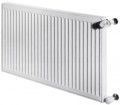Heat transfer medium volume
The volume of water or other heating medium required to fill the radiator.
This information is relevant mainly when building an autonomous heating system: it is useful when calculating the total volume of heating medium in the system and related parameters. If the radiator is purchased for use in centralized heating, you can not pay much attention to its internal volume.
Connection
How to connect a radiator to a heating system. It is indicated by the location of the inlets for connecting the supply and return.
In modern radiators, both
side and
bottom connections are found. In the latter case, the inlet and outlet pipes can be located both on the sides (on different sides of the structure) and in the centre, side-by-side. Anyway, this feature does not affect the functionality and specs of the radiator. At the same time, it must be borne in mind that the sideward connection can involve both one-sided and dual-sided (from different sides) pipe connection; many models allow both options at once, to choose from, but this point needs to be specified separately.
Note that the available connection methods depend to some extent on the type of radiator (see above). For example, panel devices can have any type of connection, and in sectional products, the sideward method is mainly used — other options are extremely rare, mainly in models of a specific design.
Pipe centre distance
The distance between the axes of the inlet and outlet manifolds of the radiator or its separate section.
The dimensions of the product and the possibility of installing the heater in specific conditions, taking into account the peculiarities of the pipe connection, directly depend on this parameter. The parameter is indicated mainly for models of traditional design - with two horizontal pipes at the top and bottom, between which vertical channels of the heat transfer are laid.
The centre distance determines at least the overall height of the product, and in radiators with sideward connection (see the corresponding paragraph), it also determines the features of the organization of this connection.
As for specific values, the most common models in our time are
250 mm,
350 mm,
450 mm,
550 mm and
850 mm. Solutions for
150 mm,
400 mm,
500 mm and
700 mm are noticeably less common.
Heat output
The rated thermal output of the radiator is the amount of heat given off to the air in normal operation.
When choosing this parameter note that the heat output will depend on the temperature difference at the inlet and outlet to the radiator, as well as on the ambient temperature. The greater the temperature difference and the colder it is around, the more intense the heating will be. Therefore, in the specs, it is customary to indicate heat transfer for certain standard conditions. In particular, the designation according to the European standard EN-442 is very popular, which assumes heating medium temperatures of +75 °С and +65 °С at the inlet and outlet, respectively, as well as an air temperature of +20 °С. Real conditions and the actual heat output of the radiator may differ; therefore, when choosing, it is best to choose a model with a certain margin and compensate for excess power with one or another regulator. As for the actual values, in the most modest models, the heat output
does not exceed 750 W, or even
500 W, and in the largest, this figure can reach
3.5 – 4 kW or
more.
The choice for this parameter depends primarily on the size and specs of the heated space. The simplest calculation formula is as follows: at least 100 W of thermal power is required per 1 m2 of area. This formula is relevant for standard r
...esidential/office premises with ceilings of 2.5 – 3 m, without problems with thermal insulation; for more specific conditions, there are more detailed calculation methods, that can be found in special sources.Radiator width
Radiator width.
In modern models, this size can be from
10 cm or even less(in separately sold sections from sectional radiators, see "Type") to
2.5 m or more(in the largest panel products and convectors). At the same time, the design uses mainly standard widths — their list is very extensive, it mainly includes options in increments of 10 cm:
30 cm,
40 cm,
50 cm,
60 cm,
70 cm 80 cm,
90 cm,
100 cm,
110 cm,
120 cm,
130 cm,
140 cm,
150 cm etc. The actual dimensions may differ slightly from the standard, but this difference does not exceed 1 cm: for example, the category "60 cm" includes models with a width of 590 to 610 mm.
The width determines two features of the radiator at once: the size of the space required for installation, as well as heat output. In the first case, everything is quite obvious; we only note that the radiator heater should be placed close to surrounding objects so that it's ok to take a certain margin in width (and if the pipes are c
...onnected sideward, it is worth considering the space required for them). As for heat output, other things being equal, a wider device will have a larger working surface area and a higher heat output (this is also true for heat exchangers in convectors). Thus, modern radiators are traditionally produced not in separate models, but in series of the same type of devices that differ only in size and thermal output.
